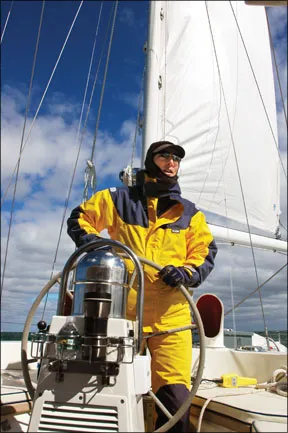
Photo by Ralph Naranjo
288
Full-finger or three-quarter-finger, mesh-back or neoprene-back, synthetic leather or rubberized latex—the options for sailing gloves today are overwhelming. You can select winter gloves or warm-weather gloves, high-tech performance models or inexpensive, garden-variety gloves—the choices are endless.
Though some sailors won’t use gloves because they say it removes natural protective oils from your skin and others maintain that gloves interfere with their grip, the majority of us consider gloves an advantage.
Because most sailors don’t handle lines often enough to keep their hands calloused, having something that not only protects your palms and digits from wear and tear, but can also enhance your grip on a line, a shroud, or the helm, is a boon. Also, padded palms and fingers can help reduce some of the muscle fatigue that gripping a steering wheel or tiller for long periods occasionally causes.
What We Tested
For this test, Practical Sailor examined the current crop of gloves that leave the wearer’s fingertips uncovered. The advantage of this design is better dexterity with knots, shackles, thumbscrews, and—of course—cans and bottle tops. (Each product we tested is also sold in a full-finger version.)
Practical Sailor obtained 12 models from eight manufacturers, all recognized names in the sailing apparel industry. We specified men’s size large, though several of the samples we received were larger. The bulk of the products we tested are made of Amara, a microfiber-based, synthetic leather that remains supple even after repeated immersion in salt water. Since this material was introduced almost 20 years ago, other materials have come on the market, but Amara remains the principal material used in sailing gloves.

288
“End use determines fabric selection and design criteria,” explained Gill President David Pritchard.
We tested only gloves designed for sailing. Some sailors may get by using other sport gloves or work gloves, but those cannot be expected to offer the grip and protection of sailing gloves nor be as durable in the marine environment. Sailing-specific gloves are designed with materials and thread that can take the abuse of UV degradation, saltwater soakings, and constant abrasion against cordage—yet still remain supple.
Gill Pro
The Gill Pro short-finger gloves (No. 7440, one of seven styles by Gill) are primarily Proton-Ultra (60 percent nylon, 40 percent polyurethane), a trademarked material. Gill claims its material doesn’t absorb water like Amara, is three times more durable, and is also warmer. The company also claims a patented, pre-curved finger design that promotes better fit and durability. A Velcro flap on the inside of the gloves’ wrists keeps it from snagging on your watch.
Testers rated this glove’s comfort Good because it was initially stiff and tight near the fingertips. It’s also apt to be hot in warmer climes. (Other Gill gloves are more suitable for warm-weather sailing.) Practical Sailor testers noted that the fabric didn’t bunch up when the hand was closed. We were impressed that the palm reinforcement wraps around the index finger and the outer edges of the pinky and heel of the hand, protecting those sailors wont to wrap a line around their hand. Our testers also liked the smooth seams between the Proton-Ultra and the neoprene-like fabric (96 percent nylon, 4 percent elastane) that runs across the back of the hand and around the fingers.
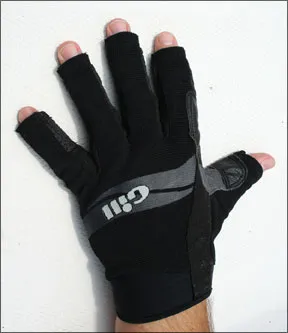
288
This was the only glove tested that has small tabs on the ends of the fingers to make removing the glove easier.
Gill uses V-cut panels between the fingers. Overall, there are 13 panels—quite a few—sewn together to form the glove. More pieces mean more seams, which means more stitching and possibly more failure points and areas of discomfort.
Pritchard explained that every seam has a specific purpose and that the company has gone to great lengths to eliminate unnecessary seams.
Bottom line: This is a well-made product with superb gripping ability and dexterity. It’s more expensive than most ($34), but we still recommend it.
Gill Championship
The Gill Championship short-finger gloves (7240) are made of Proton-Ultra with Kevlar reinforcement. The company claims excellent grip and durability with this product as well as good dexterity.
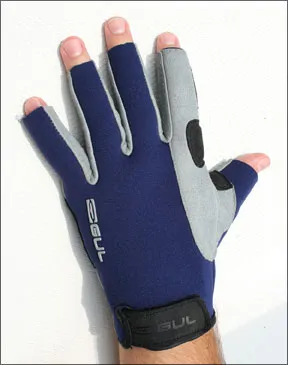
288
Like the Gill Pro, the Championship glove also features a Velcro closure on the inside of the wrist, but this glove appears to be constructed less for heavy-weather sailing because the fabric is lighter and the reinforcements don’t extend as far around the index finger or heel.
Gill employs a quilted Kevlar weave to reinforce the outer fingers and provide greater grip. Practical Sailor’s grip tests found this to be quite effective. Regarding comfort, our testers were less impressed. This glove seemed too tight around the web area between the fingers. Though its grip was good, it wasn’t quite as good as its more expensive sibling.
The Gill Championship comes in seven sizes and sells for $27. (Gill also manufactures a Regatta Deckhand Glove in the short-finger model for $20 and a latex glove for $6, neither of which Practical Sailor tested.)
Bottom line: Good grip and construction make this product a contender, but less-than-ideal comfort holds it back.
Gul Anatomic Cut
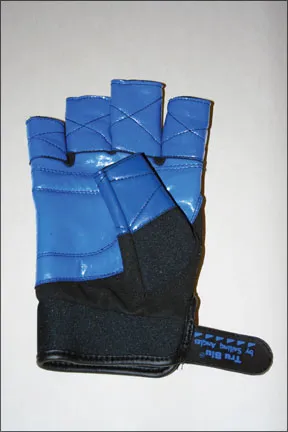
288
The Gul Anatomic Cut neoprene gloves are made of neoprene and Amara. (The label stipulates 25 percent polyurethane, 37 percent nylon, 30 percent neoprene, and 8 percent PVC.) One of the most expensive products in this collection ($35), these gloves include a neoprene back and Amara-and-foam reinforcement in the palm and finger bottoms. The adjustable Velcro closure is on the top of the wrist.
Our testers found the XL gloves’ fit comfortable but snug.
The foam in the palm tends to bunch up when the hand is closed over a line, limiting the effectiveness of the grip. The Gul was rated Good for grip. The Amara reinforcing extends over part of the index finger (where a wrapped line is apt to apply pressure), but Practical Sailor testers would prefer that it extend farther over the heel on the opposite side of the hand for the same purpose.
Straightforward construction on this glove means only seven panels in all (discounting the individual patches of Amara beneath each finger and the small Velcro flaps) make up the product. Given that, it’s surprisingly comfortable.
Bottom line: A well-fitting, very comfortable glove. Its grip was not as exceptional as the top performers.

288
Harken Black Magic
Ten years old, Harken’s Black Magic gloves are made of two synthetic leathers (Black Magic and Amara) and a nylon Spandex mesh. The company claims that all of its gloves (seven models are available) offer the “ideal combination of dexterity, abrasion-resistance, and grip.” Practical Sailor testers were particularly impressed by the Black Magic’s flexibility and comfort, which both enhance dexterity.
These gloves are made in China using 14 separate pieces of material. Curiously, where different fabric types meet, the company uses double stitching, but only single stitching in the main seams, like along the outer edge of the hand between the palm and the top of the hand where the Spandex attaches to the other materials.
The Black Magic Glove is available in six sizes for $27.
Harken employs its proprietary Black Magic fabric to reinforce the palm, thumb, and underside of the fingers. The inside of the index finger is well protected, but the fabric doesn’t extend far up the heel. For a wrist closure, Harken uses a full 2-inch, Velcro strap on the back of the wrist, leaving it open to snags.
Bottom line: With a comfortable fit and a reasonable price, these are held back only by their less-than-excellent grip.
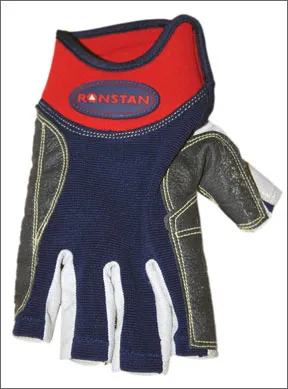
288
Harken Reflex Performance
Introduced just a year ago, the Harken Reflex Performance glove (2083) is more form-fitting than the Black Magic. The company claims that the Black Magic material used to reinforce the palm, thumb, and fingers is specifically designed to grip contemporary line products made from synthetic fibers.
The back of the Reflex Performance glove is a nylon mesh. The seams between the mesh and the Black Magic reinforcement run along the top sides of the fingers, so they are not in the way when the fingers close over a line, shroud, or wheel.
The mesh is also used for ventilation and comfort in the webbed areas between the fingers. The only foam in this glove is in a small section protecting the heel of the hand.
Made in China, the Reflex Performance comprises 13 pieces of material. All of the overlays are double-stitched, but most seams (and the piping that surrounds the wrists) are single stitched. The gloves have a Velcro closure on the underside of the wrist. There are also two molded rubber strips that run up the back of the glove from the wrist area to the last knuckles on the pinky and ring fingers for protection.
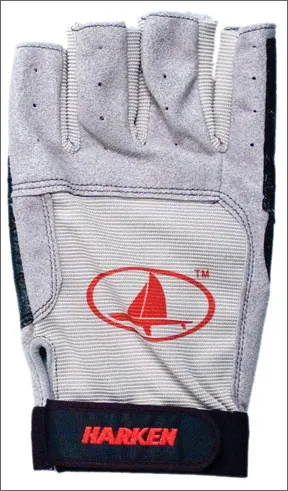
288
This glove comes in six sizes and sells for $38.
Bottom line: This is a well-made product that provides excellent grip and superior dexterity, if not ideal comfort. It’s the most costly glove in the field, but if it can outlast the others, it will be worth the price. Recommended.
Henri Lloyd Stealth MaxGrip
The Stealth MaxGrip glove by Henri Lloyd is a sturdy product that at first seemed stiff to testers. Produced in China, this glove uses a proprietary material dubbed MaxGrip, which company literature describes as having a rubberized, high-grip texture that offers improved articulation and protection against rope burn.
The Stealth MaxGrip uses Kevlar thread throughout and has a nylon mesh back reinforced with a contoured strip of MaxGrip fabric just behind the largest set of knuckles. The mesh back is flexible, light, and dries quickly. The MaxGrip reinforcing around the fingers isn’t attached to the palm, which one tester liked because it allows for freer movement there. Though this product is made from 13 pieces of fabric, every seam except those on the outer thumb, heel, and outer edge of the pinky, is double-stitched.
Practical Sailor testers felt that this product ultimately was comfortable and that the MaxGrip material grabbed the line very well. The fingers are longer than several of the others, so some wearers’ dexterity will be challenged.
One feature we truly like is the Velcro closure, which fastens on the underside of the wrist. At a full 3 inches, it’s the longest and most secure strap in this test. This glove is sold in five sizes for $28.
Bottom line: This is a very well made, comfortable glove with superior gripping ability and a reasonable price—a good choice for people with long fingers.
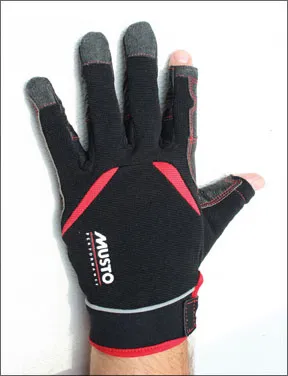
288
Henri Lloyd Stealth Pro
The Stealth Pro by Henri Lloyd is an Amara and nylon mesh glove, and it was testers’ favorite as far as comfort. Its design provides a smooth, snug fit and better articulation than the Stealth MaxGrip.
Two main panels of fabric comprise this product: nylon mesh on the back and Amara on the palm and fingers. There are double layers of Amara on the palm and the inside of the thumb and fingers. That same reinforcement wraps generously over the heel of the hand and the base of the index finger. All of the reinforcement is double-stitched with Kevlar thread.
The Stealth Pro glove has a 3-inch panel of Velcro sewn onto an elastic strap that wrings the wrist. It makes for a secure closure, but our testers question the longevity of the elastic—something we plan to rate in our long-term test. Made in China, this glove comes in five sizes and sells for $22.
Bottom line: With solid construction, superior comfort, and above-average gripping, the Stealth Pro is one of the top products in this test and easily our Budget Buy.
Musto Performance
The Musto Performance glove is the only one tested with three fingers fully covered. Known for its performance sailing apparel, Musto makes a number of glove styles including a short-finger model of the Performance glove, but we were unable to obtain a pair for this test. We didn’t rate this glove relative to dexterity due to that anomaly.
Using an Amara-like fabric that Musto calls “grip fast” on the palms and fingers, this glove has a single panel of nylon mesh across the back and along the tops of each finger. The palm and the underside of the fingers have a double layer of “grip fast,” which is wrapped generously around the side and top of the index finger but not the side of the heel. All the reinforcement is double-stitched.
Musto’s glove is one of two products we tested that has reflective piping. The glove fastens by way of a Velcro strap on the underside of the wrist for added security. Practical Sailor testers were divided on rating the Musto’s comfort: One gave it a strong rating, but another felt it was bulky by the heel. Nonetheless, they were unanimous regarding its strong gripping ability.

Photo by Ralph Naranjo
288
0)]
Bottom line: An apple among oranges due to its design, this is a well-made glove with superior gripping ability. We’d likely recommend the company’s short-finger version, particularly at its below-average price.
Ronstan’s Sticky Race
Introduced in 2007, the Sticky Race glove (RF4850L) by Ronstan is made primarily of Amara. The company says this affords “maximum durability, minimum stretch and shrinkage.” However, Ronstan’s main claim is that the glove’s sticky material reduces hand fatigue by minimizing the effort required to hold rope. In the areas of high wear—the palm and inner fingers—Ronstan uses Aramid thread at the seams, as it is supposed to be more durable.
The Ronstan sticky glove has reinforcement across the palm and finger bottoms that continues over the heel and part way up the index finger. Practical Sailor testers would prefer that it extended another half-inch in this area.
This glove does have the most ergonomic cuff among all of our test products. The chief advantage of this glove’s construction is that it’s made of fewer pieces of material (10), hence fewer seams with less stitching exposed to wear and tear.
Ronstan also uses a Velcro flap on the inside of the wrist to close the glove’s neoprene cuff on the underside of the wrist. A small inner tab keeps the closure from inadvertently opening if rubbed against a shroud or other object. Made in China, this glove comes in eight sizes and sells for $30.

Photo by Ralph Naranjo
288
3)]
Bottom line: A very comfortable product, particularly in warmer climes. It offers good protection and extraordinary dexterity, but disappoints in the grip department with high-tech exotic lines. If you don’t use this type of line, the gloves are a good buy.
Sailing Angles Kontrol
The Kontrol Gloves by Sailing Angles are made primarily of Amara and are advertised to “stay soft when dry and breathe while drying.” The company’s literature also claims that the gloves’ toughness is belied by their supple feel. Practical Sailor testers did find these gloves to be supple.
Sailing Angles specializes in performance sailing apparel and uses a proprietary material it calls Zeptep as reinforcement in the palms and on the finger bottoms. Zeptep, which the company describes as an “aggressive basketball-textured nonskid,” appears to enhance the grip, and the company claims that it’s even better when wet. We found that it works just as well wet or dry.
The reinforcing wraps well over the heel of the hand, which we like. This glove has an elastic wrist cuff that closes on the back of the wrist by way of a Velcro flap. One tester noted the looseness of the elastic material.
In our grip tests, the Zeptep did grip the lines well, but because the additional layer of this thick material adds bulk to the palm—there’s also foam padding inside—it tends to bunch up when the hand closes.
The Kontrol was on of the few pair of test gloves that had a noticeably foul smell following the odor resistance test. It was a familiar smell—like when you discover you’ve left a wet T-shirt in the bottom of the dinghy for a week—that rank, slightly pungent marine flavor. The odor test results did not weigh heavily in our final ratings, as we figure, with proper care, the smells our test created can be avoided.

Photo by Ralph Naranjo
288
1)]
The Sailing Angles Kontrol sell for $27.50 and come in eight sizes.
Bottom line: This glove is well made, but its grip was lacking compared to many others. We liked the Zeptep material for its grip, but not the bulk in the palm.
Sailing Angles Tru Blu
The Tru Blu gloves by Sailing Angles are made almost entirely of neoprene with a latex, rubberized reinforcement sewn around the fingers and over the palm. This reinforcement, which Sailing Angles proprietor Donald Elliott describes as “grippy,” offers a surprisingly secure grip on line or metal. These gloves provided the best grip of all 12 pairs tested.
Practical Sailor testers were surprised that these gloves fit well as they were sized XXL. They were rated average for comfort, mostly due to the thickness of the material, which renders the fingers stiff and would be hot in warmer climes. Our testers were also surprised at the good dexterity these gloves allow even though the finger sections are thick and long.
Bottom line: If grip is the objective, these are your gloves, which we tapped as the Practical Sailor Best Choice. However, be prepared to sacrifice some comfort and buy a size larger than you think you need. Serious offshore sailors should be happy to pay $30 a pair for these quality gloves.
West Marine
West Marine’s three-quarter-finger sailing glove is inexpensive ($20) and seemingly well made. This product, which is made in Pakistan under a contract with Gill, contains 70 percent Amara, 20 percent nylon lycra, 5 percent neoprene, and 5 percent other “undisclosed” materials. The company recommends this product be used in small-boat sailing or inshore cruising.
West Marine boasts “seamless finger construction and a contoured fit for comfort” on this glove. Practical Sailor testers rated these gloves among the top three in the test for comfort. But “seamless finger construction,” simply means that the palm panel is the same piece of material that forms the lower portion of each finger, which is no different than most of the other gloves tested here.

Photo by Ralph Naranjo
288
2)]
Like several other models tested, West Marine’s glove provides a double layer of Amara on the heel, but that double layering doesn’t extend as far as our testers would like around the base of the index finger.
The glove has a form-fitting neoprene wrist cuff that closes on the wrist underside by way of a Velcro tab, and it has a reflective stripe running across the back. One potential drawback to this product is that only the heel and thumb sections of the Amara reinforcement are double-stitched.
Bottom line: A very comfortable, inexpensive glove with average grip. Apart from the single-stitched seams, this is a well-made product for inshore use. It narrowly missed our Budget Buy pick.
Conclusions
What most sailors truly need in a glove is a comfortable fit, hand protection, and a good grip. A good sailing glove will enable the sailor to use his or her hands for functions that require dexterity. Aside from that, you want durability.
All of the products we tested are quality gloves, and picking the cream of the crop was no easy task. We leaned heavily toward those with Excellent grip, but buyers should choose a pair according to their needs, sailing conditions, and sailing style.
Based on all of the ratings, Sailing Angles’ Tru Blu is our Best Choice and is particularly well-suited for helmsmen. The other top performers are the Gill Pro and Harken Reflex Performance. Rated Excellent for grip and dexterity, both are well-suited for trimming and general use. At only $22, the Henri Lloyd Stealth Pro gets the Budget Buy pick. It was rated Excellent for comfort and Very Good for grip. We’ll see how they all weather the long-term test.
Regardless of the glove you buy, get the right fit by properly determining your size. Keep in mind that glove sizes are usually equivalent to your T-shirt size.





































